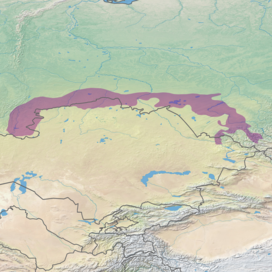

| Kazakh forest steppe | |
|---|---|

Open mine near Magnitogorsk, Russia, at the western edge of the Kazakh forest steppe
| |

Ecoregion territory (in purple)
| |
| Ecology | |
| Realm | Palearctic |
| Biome | temperate grasslands, savannas, and shrublands |
| Borders | List |
| Geography | |
| Area | 422,360 km2 (163,070 sq mi) |
| Countries |
|
| Conservation | |
| Protected | 50,222 km2 (12%)[1] |
The Kazakh forest steppe ecoregion (WWF ID: PA0809) is a long thin strip of transition zone between the forested taiga of Siberian Russia (to the north), and the Kazakh steppe to the south. The ecoregion stretches over 2,000 km from the southern Ural mountains in the west to the foothills of Altai mountains in the east, yet averages only 200 km from south to north across its length. Because the region is farther inland than European forest steppe, and some 300 to 500 km farther north, the climate is more continental and with less precipitation the tree cover more sparse. The ecoregion is in the Temperate grasslands, savannas, and shrublands biome, and the Palearctic realm, with a Humid Continental climate. It covers 420,614 km2 (162,400 sq mi).[2]
The ecoregion stretches along the border between Russia and Kazakhstan, mostly on the northern (Russian) side, with a few small sections in Kazakhstan proper. The terrain is relatively flat lowland plains, with wetlands in the depressions and strips of trees following water courses on the sandy soil.[3][4] To the north is the West Siberian taiga ecoregion; to the south is the Kazakh steppe.
The climate of the region is Humid continental climate, warm summer (Köppen climate classification (Dfb)).[5][6] This climate is characterized by high variation in temperature, both daily and seasonally; with long, cold winters and short, cool summers with no month averaging over 22 °C (72 °F). There is just sufficient precipitation (averaging 330 mm/year) to support patchy stands of trees. The mean temperature at the center of the ecoregion is −17.6 °C (0.3 °F) in January, and 19.7 °C (67.5 °F) in July.
The region exhibits the typical forest steppe mix of grasslands and forest too sparse to create a full canopy. Typical trees are birch, aspen and pine, often growing in small groves called 'kolky', with the pine trees often growing in long strips of sandy soil in formations called 'ribbon forests'. Swamps are common. The region was about 15% forested; this has been reduced by human activity. The most common grass is Calamagrostis epigejos (bushgrass).[3] A study in 2003 indicated that the small portion of the Kazakh forest steppe that is actually in Kazakhstan (about 21,000 Km2) shows cover that is 13% planted in spring wheat, 37% in dryland cropland/pasture, and 51% in a mosaic of cropland and forest.[7]
There are two significant protected areas in the Kazakh forest steppe ecoregion;